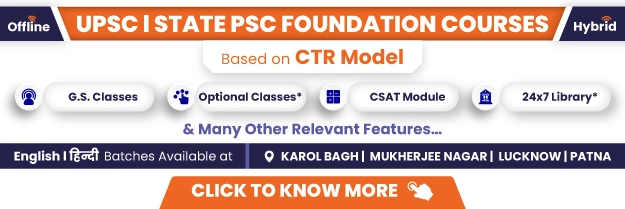- The Gupta Rule for witnessing all round progress i.e., in spheres of art, architecture, literature, science and technology, metallurgy and philosophy, regarded as the Golden Age of Ancient India.
- Stable polity, profitable trade, secured and peaceful social set up provided the required conducive environment for development of North India.
- Sri Gupta was the first ruler of the Gupta Dynasty followed by his son.
- Bhitari pillar inscription dates to his reign gives the chronology of Guptas and his conflict with Pushyamitra and Huns.
Enroll now for UPSC Online Course
| RULER OF GUPTA EMPIRE |
RELATED INFORMATION ABOUT GUPTA EMPIRE |
| Gupta Empire – CHANDRAGUPTA-I
(319 CE – 330/335 CE) |
- First important ruler of the Gupta Empire was Chandragupta-I (319 CE – 330/335 CE) who is considered the actual founder of the Gupta Dynasty.
- He assumed the title of ‘Maharajadhiraj’.
- His reign covered regions of South Bihar, Jharkhand and parts of Eastern Uttar Pradesh (Saketa and Prayaga).
- His accession in about AD 319-20 marks the beginning of the Gupta Samvat (era).
- Chandragupta-I married the Licchavi princess Kumardevi and increased his influence in the North Bihar region (Nepal).
- Gold Coins bearing the figures of Kumardevi and Chandragupta 1st known as Kumardevi Coins were issued.
|
| Gupta Empire – SAMUDRAGUPTA (335 CE – 375/380 CE) |
- The son of Chandragupta-I, Samudragupta, became the next ruler of Gupta Empire whose conquests are recorded in Prayaga Prashasti (Eulogy).
- These conquests Prayaga Prashasti were composed by Samudragupta’s court poet, a scholar and minister, Harishena in classical Sanskrit.
- According to Prayaga Prashasti, Samuddragupta conquered: Eight kings of Aryavarta – (northern India i.e., Ganga Valley);
- Samudragupta captured and then liberated and reinstated 12 kings of Dakshinapatha (South India).
- A large part of the subcontinent succumbed to the power of Samudragupta and paid tribute.
- Samudragupta performed the Ashwamedh Yajna (sacrifice) after these achievements.
- He issued Ashwamedh coins, Tiger-slayer coin, Battle-axe coin and Veena-Coin in which he is displayed playing the Veena.
- Samudragupta was not only a conqueror but also a great poet, musician and patron of learning.
- Samudragupta’s successful conquests has earned him the title of ‘Napoleon of India’.
- Allahabad pillar inscriptions called him “Dharma Prachar Bandhu”.
|
|
Gupta Empire – CHANDRAGUPTA-II
(380 CE – 414 CE) |
- Coming to the throne, Chandragupta-II defeated the Sakas in western region (Gujarat, Kathiawar and west Malwa), assumed the title of ‘Vikramaditya’ and ruled from Ujjain.
- Udayagiri Cave Inscription (Vidisha, MP) and Sanchi inscription inform us about this.
- He married Kubernaga of the Naga family and had a daughter by her name Prabhavatigupta.
- Prabhavatigupta was married to Vakataka Rudrasen 2nd of Central India, after Rudrasen’s death, Prabhavatigupta ruled as a regent between 390 CE to 410 CE.
- Chandragupta-II was the first ruler of Gupta Empire to issue silver coins bearing lion figures similar in pattern with Saka coins.
- Mehrauli iron pillar inscription (Delhi’s Qutub-minar complex) of Chandragupta-II records that Chandragupta-II defeated Valikas of Bacteria crossing the Sapta Sindhu.
- Kalidasa and Amarsinha lived in his court.
- Chinese Buddhist monk Fa-hsien visited his court.
|
| Gupta Empire – KUMARGUPTA I
(414 CE – 455 CE) |
- Karamdanda (Fyzabad) inscription refers to king Kumaragupta I as ruler of 4 oceans, Mandsor inscription as ruler of all earth and copper plate inscription of Damodarpur as ‘Maharajadhiraj’.
- Bilsad (Etah) inscription also mentions Kumaragupta I
- Kumaragupta I performed Ashwamedha yajna and assumed titles like Ashwamedha-Mahendra and Mahendraditya
- Himself a devotee of Shiva, Kumargupta I issued Kartikeya type coins bearing the figure of peacock.
- While the threat of the Hunas crossing Hindukush was building up during Kumargupta I, on the whole his reign remained peaceful.
- During his reign Nalanda University was established.
|
| Gupta Empire – SKANDAGUPTA
(455 CE – 467 CE) |
- Son of Kumargupta I, Skandgupta, during his lifetime bravely fought and defeated Hunas on the North-Western frontier.
- His conquest over Pushyamitra is marked in Bhitari Pillar inscription.
- Got the Sudarshan Lake repaired (Junagadh inscription).
- Skandagupta’s death in 467 CE was followed by incompetent successors who could not keep the empire intact.
|
| Decline of Gupta Empire |
- Feudal lords (recipients of the land grants) started asserting themselves and started setting up their own dynasties.
- Decentralized bureaucracy and absence of a large, permanent and professional army were important factors of decline.
- Decline of foreign trade, invasions of Huna, weak successors contributed to their decline
- Vishnugupta (540 CE- 550 CE) was the last recognized Gupta ruler.
|
Enroll now for UPSC Online Classes
| SOCIO-ECONOMIC CONDITION DURING GUPTA EMPIRE |
|
ADMINISTRATION SITUATION DURING GUPTA EMPIRE |
- King was assisted by the council of ministers.
- Bhukti (province) and Vishaya (province division) were administrative units headed by Uparika and Vishayapati respectively.
- Vishaya was further divided into Vithi & village was the smallest unit.
- Bureaucracy was not elaborated as that of Maurya.
- Important Offices:
- Mahanandanayaka – Justice Delivery
- Mahapratihara – Chief of the Guards
- Dutakas– Associated with Gifts and Grants
- Sandhi–Vigrahika– Minister of Peace and War
- Pilupati -Headed Elephants
- Asvapati -Headed Horses
- Narapti– Headed Foot Soldiers
- Ranabhandagrika– In charge of stores
- Akshapataladhikrita– Superintendent of Records and Accounts.
|
|
ECONOMY UNDER GUPTA EMPIRE |
- Agriculture, trade, commerce and art and crafts all flourished under Guptas.
- The King’s administration facilitated irrigation, ensured measurement and categorization of land into cultivated (Kshetra) and un-cultivated (Khila/ Aprahata) lands.
- Landowner class (mahattars, Gramika and Kutumbika) became influential as land was a prestigious property to be sold or gifted.
- Craftsmen produced both utility and luxury items; particular craftsmanship became the basis of ‘jaati’-formation i.e., caste.
- Shreni continued to govern the trader’s affairs.
- Common people traded in cowrie shells.
- Issued less pure gold coins than Kushana.
|
| SOCIETY AND RELIGION UNDER GUPTA EMPIRE |
- Society became clearly feudalistic, Brahmins (Brahmadiyas & Agraharas)and feudal chiefs received land grants.
- Position of women and Shudras improved. Both were allowed to listen to the Ramayana & Mahabharata & advised to worship Krishna.
- Bhanugupta’s Airana (Eran) inscription gives the first evidence of Sati and Child marriage too existed.
- Fahien records almost no crime and death penalty.
- Vishti was forced to serve the royal army & officials.
- Chandalas were the outcaste i.e., out of the 4-fold varna system and made to reside outside village settlements.
- Different religious sects co-existed peacefully.
- Vaishnavite or Shaivite Kings got temples constructed for their respective deities.
- Religious texts like Puaranas, Mahabharata and Ramayana were expanded in this period.
- Bhagvatism centered around Vishnu emerged.
|
|
ART AND ARCHITECTURE UNDER GUPTA EMPIRE |
- Continud growth of the Ajanta School (Theme: Buddha’s life) was accompanied by emergence of Bagh School near Hoshangabad in Madhya Pradesh. In this cave-walls were decorated (painted) in local themes i.e., it related to common people.
- Sculpture– made considerable growth with evidence of various stone images.
- Metal and stone images of Buddha (bronze, Bhagalpur), Shiva and Vishnu are reported from a number of places.
- Images of God appeared for the first time.
- Stupa and cave construction reduced and temple construction (Shikhara) picked up:
- Dashavatar Temple, Jhansi, U.P.
- Bhitargav Temple (Brick) Kanpur, U.P.
- Parvati Temple, Nachnakuthara, M.P.
- Vishnu Temple, Jabalpur, M.P.
- Bagh cave Paintings belong to this period.
|
Enroll now for UPSC Online Coaching
| LITERATURE DURING GUPTA EMPIRE |
- Development of literature in Gupta Empire was diverse as it covered from poetry and play, art (dance and music), philosophy, religion to science, mathematics, physiology, astronomy etc.
- There were Navaratnas, or Nine Gems in the court of Chandragupta II who were experts of particular fields. These were: Amarsimha, Dhanvantri, Harisena, Kalidasa, Kahapanaka, Sanku, Varahamihira, Vararuchi, Vetalbhatta.
- Dharmashashtras, Narad Smriti, Vishnu Smriti, Brihaspati Smriti and portion of Ramayana and Mahabharata, Bhasa’s 12 plays were also written in this period.
- Most of the literature is developed using ornate Sanskrit language.
| AUTHOR |
WORK |
| Kalidasa
|
- Abhijnanshakuntalam
- Vikramorvasiyam
- Malavikagnimitra
- Kumārasambhava
- Raghuvansham
- Meghadootam
- Ritusamhara
- Jyotirvidabharana
|
| Kamandaka |
|
| Vishakhadatta |
- Mudrarakshas
- Devichandraguptam
|
| Gunadhya |
|
| Sudraka |
|
| Varahamihir |
- Panchasiddhantika (5 books, Brihatsamhita most notable)
|
| Susrut |
|
| Vagabhata |
|
| Dhanavantari |
|
| Amar Singh |
|
| Aryabhatt |
- Aryabhattiyam, Suryasidhanta
|
| Brahmagupta |
|
| Bhasa |
|
Also Read: Pallava Dynasty: History, Art, Culture, Conflicts, and Decline













